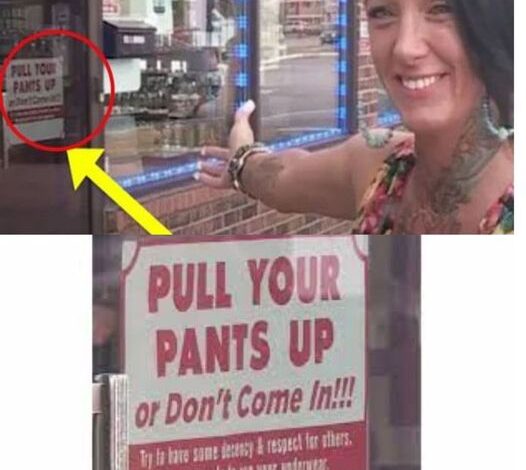**Dress Codes and Public Decorum: The “Pull Your Pants Up” Debate**

ADVERTISEMENT
**Dress Codes and Public Decorum: The “Pull Your Pants Up” Debate**
In recent years, the enforcement of dress codes in public and private spaces has become a point of contention, sparking debates about personal freedom, cultural expression, and social norms. The image of a sign reading, “PULL YOUR PANTS UP or Don’t Come In!!!” outside a storefront brings this issue to the forefront, raising questions about the balance between individual rights and communal standards.
**The Origins of the Sagging Pants Trend**
The trend of wearing pants low enough to reveal underwear, commonly referred to as “sagging,” has roots in various cultural movements, including hip-hop and urban street fashion. For some, sagging is a form of self-expression and identity, a way to align with certain cultural or social groups. However, the trend has also faced criticism, with detractors arguing that it conveys a lack of respect or decorum in public spaces.
**Why Businesses Enforce Dress Codes**
Businesses, especially those in the service industry, often implement dress codes to create a certain atmosphere or maintain a level of professionalism. The sign in the image reflects this intention, urging customers to adhere to a standard of dress that aligns with the business’s values. In this case, the sign requests customers to pull their pants up, implying that visible underwear is considered inappropriate for the establishment.
ADVERTISEMENT
These dress codes are typically meant to ensure that all customers feel comfortable and that the environment remains family-friendly. While the enforcement of such codes might seem strict, businesses argue that they have the right to set standards that they believe will benefit their operations and clientele.
**The Debate Over Public Dress Standards**
The enforcement of dress codes like the one in the image has sparked considerable debate. Supporters argue that businesses should be allowed to set rules that reflect their desired image and the preferences of their target audience. They contend that public decency and respect for others are important considerations in shared spaces.
On the other hand, critics argue that such rules can be discriminatory or infringe on personal freedoms. They point out that what is considered “decent” or “respectful” is often subjective and culturally biased. For some, being told how to dress in a public or commercial space can feel like an overreach, especially when it targets specific styles associated with particular demographics.
**The Role of Social Norms**
ADVERTISEMENT
Social norms play a significant role in shaping expectations around dress. These norms vary widely depending on cultural background, geography, and social context. What is considered acceptable attire in one setting might be viewed differently in another. The sign’s directive to “pull your pants up” is a reflection of a particular community’s values and expectations, but it may not resonate with everyone.
As society becomes increasingly diverse, the challenge lies in finding a balance between respecting individual expression and maintaining community standards. This balance is not always easy to achieve, and it often leads to tensions and disagreements.
**Conclusion**
The “Pull Your Pants Up” sign represents more than just a dress code; it is a symbol of the ongoing conversation about public decorum, cultural expression, and the role of businesses in enforcing social norms. While opinions on this issue vary, it highlights the broader discussion about how we navigate shared spaces and respect the diverse ways in which people choose to present themselves.
As these debates continue, it is essential to approach them with empathy and an understanding of the different perspectives involved. Whether you agree with such dress codes or not, they offer an opportunity to reflect on the values we hold as individuals and as a society.
ADVERTISEMENT
Let me know if you need any further information or if you’d like the article to take a different direction!




